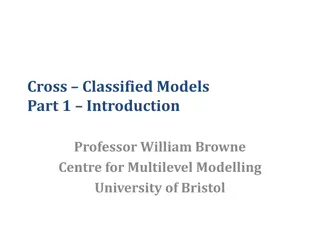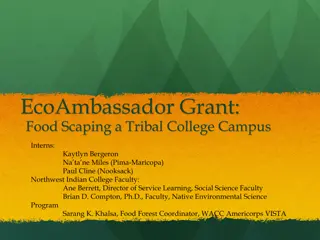Global Climate Models
Scientists simulate the climate system and project future scenarios by observing, measuring, and applying knowledge to computer models. These models represent Earth's surface and atmosphere using mathematical equations, which are converted to computer code. Supercomputers solve these equations to pr
3 views • 15 slides
Why Starting with Cinema is Crucial for a Successful New Product Launch
Launching a new product in today's media landscape can be challenging, with fragmented audiences and intense competition for attention. Starting with cinema in your audiovisual mix can be highly effective in maximizing reach, attention, and trust for your brand. Cinema offers unparalleled levels of
4 views • 11 slides
System Models in Software Engineering: A Comprehensive Overview
System models play a crucial role in software engineering, aiding in understanding system functionality and communicating with customers. They include context models, behavioural models, data models, object models, and more, each offering unique perspectives on the system. Different types of system
6 views • 33 slides
Input-Output Models in Economics
Input-Output models, pioneered by Wassily Leontief, depict inter-industry relationships within an economy. These models analyze the dependencies between different sectors and have been utilized for studying agricultural production distribution, economic development planning, and impact analysis of i
9 views • 7 slides
Multi-Head Attention Layers in Transformers
Sitan Chen from Harvard presents joint work with Yuanzhi Li exploring the provable learnability of a multi-head attention layer in transformers. The talk delves into the architecture of transformers, highlighting the gap between practical success and theoretical understanding. Preliminaries, prior w
3 views • 38 slides
Models of Teaching for Effective Learning
Models of teaching serve as instructional designs to facilitate students in acquiring knowledge, skills, and values by creating specific learning environments. Bruce Joyce and Marsha Weil classified teaching models into four families: Information Processing Models, Personal Models, Social Interactio
1 views • 28 slides
Advancements in Air Pollution Prediction Models for Urban Centers
Efficient air pollution monitoring and prediction models are essential due to the increasing urbanization trend. This research aims to develop novel attention-based long-short term memory models for accurate air pollution prediction. By leveraging machine learning and deep learning approaches, the s
2 views • 17 slides
Significance of Models in Agricultural Geography
Models play a crucial role in various disciplines, including agricultural geography, by offering a simplified and hypothetical representation of complex phenomena. When used correctly, models help in understanding reality and empirical investigations, but misuse can lead to dangerous outcomes. Longm
1 views • 8 slides
CGE and DSGE Models: A Comparative Analysis
Explore the similarities between Computable General Equilibrium (CGE) models and Dynamic Stochastic General Equilibrium (DSGE) models, their equilibrium concepts, and the use of descriptive equilibria in empirical modeling. Learn how CGE and DSGE models simulate the operation of commodity and factor
4 views • 15 slides
Enhancing Information Retrieval with Augmented Generation Models
Augmented generation models, such as REALM and RAG, integrate retrieval and generation tasks to improve information retrieval processes. These models leverage background knowledge and language models to enhance recall and candidate generation. REALM focuses on concatenation and retrieval operations,
2 views • 9 slides
Attention and Concentration: Key Aspects and Determinants
Attention is our ability to focus on specific stimuli while disregarding distractions. It can be categorized into focused, sustained, divided, and alternating attention. External and internal factors influence our attention levels. The nature of stimuli plays a crucial role in capturing attention ef
1 views • 19 slides
Discrete Optimization in Mathematical Modeling
Discrete Optimization is a field of applied mathematics that uses techniques from combinatorics, graph theory, linear programming, and algorithms to solve optimization problems over discrete structures. This involves creating mathematical models, defining objective functions, decision variables, and
2 views • 12 slides
Observational Constraints on Viable f(R) Gravity Models Analysis
Investigating f(R) gravity models by extending the Einstein-Hilbert action with an arbitrary function f(R). Conditions for viable models include positive gravitational constants, stable cosmological perturbations, asymptotic behavior towards the ΛCDM model, stability of late-time de Sitter point, a
1 views • 12 slides
Models for On-line Control of Polymerization Processes: A Thesis Presentation
This presentation delves into developing models for on-line control of polymerization processes, focusing on reactors for similar systems. The work aims to extend existing knowledge on semi-batch emulsion copolymerization models, with a goal of formulating models for tubular reactors. Strategies, ba
0 views • 16 slides
N-Gram Models in Language Modelling
N-gram models play a crucial role in language modelling by predicting the next word in a sequence based on the probability of previous words. This technology is used in various applications such as word prediction, speech recognition, and spelling correction. By analyzing history and probabilities,
0 views • 101 slides
Information Retrieval Models and Processes
Delve into the world of information retrieval models with a focus on traditional approaches, main processes like indexing and retrieval, cases of one-term and multi-term queries, and the evolution of IR models from boolean to probabilistic and vector space models. Explore the concept of IR models, r
1 views • 65 slides
Cross-Classified Models in Multilevel Modelling
Cross-classified models in multilevel modelling involve non-hierarchical data structures where entities are classified within multiple categories. These models extend traditional nested multilevel models by accounting for complex relationships among data levels. Professor William Browne from the Uni
2 views • 13 slides
Hierarchical Attention Transfer Network for Cross-domain Sentiment Classification
A study conducted by Zheng Li, Ying Wei, Yu Zhang, and Qiang Yang from the Hong Kong University of Science and Technology on utilizing a Hierarchical Attention Transfer Network for Cross-domain Sentiment Classification. The research focuses on sentiment classification testing data of books, training
0 views • 28 slides
General Equilibrium Models and Social Accounting Matrices
General Equilibrium Models (CGE) and Social Accounting Matrices (SAM) provide a comprehensive framework for analyzing economies and policies. This analysis delves into how CGE models help simulate various economic scenarios and their link to SAM, which serves as a key data input for the models. The
0 views • 50 slides
Psychology Review Questions on Attention and Perception
Explore ungraded review questions on topics like the Stroop effect, visual attention, eye movement tracking, feature integration theory, and more. Test your knowledge and understanding of concepts related to attention and perception in psychology. Use visual aids and prompts to demonstrate your answ
1 views • 8 slides
Attention Autism: A Creative Approach for Building Communication Skills
Attention Autism is a highly engaging method for developing attention and early communication skills, beneficial for all children. It involves motivating activities, shared experiences, and clear communication. The approach consists of stages such as focusing attention, sustaining attention, shiftin
0 views • 8 slides
Composite Models in Building Complex Systems
Composite models are essential in representing complex entities by combining different types of models, such as resource allocation, transport, and assembly models. Gluing these models together allows for a comprehensive representation of systems like the milk industry, where raw materials are trans
0 views • 27 slides
The Economy and Ecology of Attention in the Digital Age
The text explores the concept of attention economy, emphasizing the scarcity of human attention in the information age. It delves into how attention has become a valuable commodity, driving global corporations to maximize engagement. Discussions cover distraction economics, the role of technology in
0 views • 13 slides
Multimodal Recurrent Attention CNN for Image Aesthetic Prediction
Using a multimodal recurrent attention neural network, MRACNN, this study proposes a unified approach for image aesthetic prediction by jointly learning visual and textual features. Inspired by human attention mechanisms, the network utilizes datasets like AVA and photo.net comments to enhance multi
0 views • 14 slides
Advances in Neural Semantic Parsing
Delve into the realm of neural semantic parsing with a focus on data recombination techniques, traditional parsers, and the shift towards domain-general models. Explore the application of sequence-to-sequence models and attention-based neural frameworks in semantic parsing tasks. Discover the evolvi
0 views • 67 slides
Attention Mechanism in Neural Machine Translation
In neural machine translation, attention mechanisms allow selective encoding of information and adaptive decoding for accurate output generation. By learning to align and translate, attention models encode input sequences into vectors, focusing on relevant parts during decoding. Utilizing soft atten
0 views • 17 slides
Trust-Based Data Governance Models and Their Impact on Personal Data Regulation
This article delves into trust-based data governance models, contrasting them with control-based models in the context of personal data regulation. It explores the challenges and benefits associated with both approaches, emphasizing the emergence of new models centered on trust such as data stewards
0 views • 11 slides
Effective Approaches to Attention-based Neural Machine Translation
This research explores innovative attention mechanisms in Neural Machine Translation, proposing a new model and achieving state-of-the-art results in English-German translation. The study focuses on improving existing attention models to enhance translation accuracy and efficiency, showcasing advanc
1 views • 15 slides
Effective Approaches to Neural Machine Translation with Attention Mechanism
This research explores advanced techniques in neural machine translation with attention mechanisms, introducing new approaches and achieving state-of-the-art results in WMT English-French and English-German translations. The study delves into innovative models and examines variants of attention mech
0 views • 49 slides
Lagged Dependent Variable Models in Regression Analysis
Lagged dependent variables are utilized in various regression models such as distributed lag models, partial-adjustment models, models with expectations, and models with serially correlated residuals. By incorporating lagged dependent variables, researchers can analyze the impact of past values on t
0 views • 11 slides
Computer Simulation Models Classification
Computer simulation models are classified based on various characteristics such as static or dynamic, deterministic or stochastic, and discrete or continuous. Static models represent systems at a specific point in time, while dynamic models depict changes over time. Deterministic models involve no r
0 views • 8 slides
Pointer Network and Sequence-to-Sequence in Machine Learning
Delve into the fascinating world of Pointer Network and Sequence-to-Sequence models in machine learning. Explore the interconnected concepts of encoder-decoder architecture, attention mechanisms, and the application of these models in tasks like summarization, machine translation, and chat-bot devel
0 views • 9 slides
Game Design Enhanced by Visual Attention Allocation
This study explores how understanding visual attention allocation can improve game design by attracting and controlling players' attention levels. The authors propose a method to estimate attention allocation using eye movement and image data. The experiment involved analyzing image complexity at fi
0 views • 20 slides
Exploring Business Models in Innovation Centers
Delve into the world of business models within innovation centers like the Wyche Innovation Centre, understanding how different models transform ideas into valuable products/services. Learn about classification, benefits of categorizing businesses based on models, and the sustainability of adopting
0 views • 12 slides
Detecting Insider Threats with Attention-Based Architecture
The research focuses on utilizing an attention-based architecture, specifically BERT, for real-time detection of insider threats by analyzing user behaviors in electronic logs. The study involves transforming raw data into actionable information for DSML through preprocessing, sequencing, and batch
0 views • 15 slides
Transformers in NLP: Evolution from RNNs to Attention Mechanism
Explore the shift from RNN-based models to Transformers in NLP tasks, addressing limitations in handling long-range dependencies. Learn about the architecture of Transformers that solely rely on Attention mechanism for improved performance.
0 views • 23 slides
Transforming Sequence Modeling with Self-Attention Mechanisms
Dive into the revolutionary research paper "Attention Is All You Need" by Ashish Vaswani, Noam Shazeer, and team, introducing the Transformer model architecture that relies solely on attention mechanisms, breaking away from traditional recurrent models. Explore how self-attention allows for parallel
0 views • 45 slides
Advanced Language Models: Enhancing Legal Reasoning and Computational Argumentation
Explore the latest in language models such as Large Language Models (LLM) and their impact on legal reasoning, computational argumentation, and recent breakthroughs in AI and NLP technology. Discover how these models predict words based on contexts, learn from data, and revolutionize various fields.
0 views • 16 slides
Understanding Information Processing Development in Children
Information processing in children involves how they perceive, analyze, and remember information over time. This cognitive development is ongoing and gradual, impacting areas such as attention, memory, processing speed, and organization of thinking. Changes in attention and sustained focus play a ke
0 views • 16 slides
Enhancing Neural Networks with Soft Attention Mechanism
Learn about Recurrent Neural Networks (RNNs) and seq2seq models, and how the soft attention mechanism is used to improve long-range associations and selective information encoding in tasks like translation. Understand the concept of content-based attention and how it enables neural networks to focus
0 views • 8 slides







































